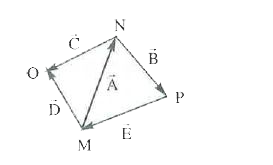Two forces P and 2P are acting at an angle θ. If thesquare of the resultant of them is equal to half of the sum of the squares of their magnitude then θ isSolution in Telugu
sin−1(58)
cos−1(−58)
cos−1(85)
0∘
The correct Answer is:B
Step by step video, text & image solution for Two forces P and 2P are acting at an angle theta. If thesquare of the resultant of them is equal to half of the sum of the squares of their magnitude then theta is by Physics experts to help you in doubts & scoring excellent marks in Class 11 exams.
Topper's Solved these Questions
- BOOK - AAKASH SERIESCHAPTER - VECTORSEXERCISE - Lecture Sheet (Exercise-I) (Addition of Vectors) (More than correct answer type Questions)2videos
VECTORS
- BOOK - AAKASH SERIESCHAPTER - VECTORSEXERCISE - Lecture Sheet (Exercise-I) (Integer Type Questions)3videos
VECTORS
- BOOK - AAKASH SERIESCHAPTER - UNITS AND MEASUREMENTS EXERCISE - ADDITIONAL PRACTICE EXERCISE (PRACTICE SHEET (ADVANCED))14videos
UNITS AND MEASUREMENTS
- BOOK - AAKASH SERIESCHAPTER - VISCOSITY EXERCISE - Questions for Descriptive Answers3videos
VISCOSITY
Similar Questions
From figure the correct relation is
 02:50View Solution
02:50View SolutionFour forces of magnitudes P, 2P, 3p and 4P act along the four sides of a square ABCD in cyclic order. If the magnitude and direction of their resultant is n√2Pand15n find the value of n
02:00View SolutionTwo clocks are being tested against a standard clock located in a national laboratory At 12 : 00 : 00 noon by standard clock, the readins of the two clocks are
DayClock - IClock - IIMonday12:00:0510:15:06Tuesday12:01:1510:14:59Wednesday11:59:0810:15:18Thursday12:01:5010:15:07Thursday12:01:5010:15:07Friday11:59:1510:14:53Saturday12:01:3010:15:24Sunday12:01:1910:15:11
From the Observations carefully read the following conclusive statements.
Statement I : Zero - error in clock II is much longer than zero - error in clock I.
Statement II : Zero - error can always be corrected by applying necessary corrective measures
Statement III : Precision of clock - I is more than precision of clock - II
Statement IV : Precision of clock - II is more than precision of clock - I
Pick up the correction option from the following.01:34View SolutionAn iron sphere of mass 20×10−3 kg falls through a viscous liquid with terminal velocity 0.5 m/sec. Find the terminal velocity of another iron sphere of mass 54×10−2 kg.
02:29View SolutionWhen two vectors of magnitudes P and Q are inclined at an angle theta , the magnitudes of their resultant is 2P. When the inclination is changed to 180^(@)-theta , the magnitudes of the resultant is halved. Find the ratio of P and Q .
02:59View SolutionSquare of the resultant of two forces of equal magnitude is equal to three times the product of their magnitude. The angle between them is
02:55View SolutionSquare of the resultant of two forces of equal magnitude is equal to three times the product of their magnitude. The angle between them is :
View Solutionसमान परिमाण के 3 न्यूटन के दो बल किसी पिण्ड पर θ कोण पर लगे है | यदि इन दोनों बलों का परिणामी बल भी 3 न्यूटन हो, तो कोण θ का मान क्या होगा ?
04:25View SolutionTwo forces of equal magnitude F are at a point. If theta is the angle between two forces then magnitude of the resultant forces will be
03:21View SolutionSquare of the resultant of two forces of equal magnitude is equal to three times the product of their magnitude. The angle between them is
02:13View SolutionTwo forces of equal magnitude F act at a point. If the angle between them is θ, then the magnitude of the resultant force is
02:22View SolutionTwo equal forces act on a body at an angle θ between them. Show that their resultant bisectos the angle θ.
02:24View Solution3N तथा 2N परिमाण के दो बल θ कोण पर इस प्रकार कार्यरत है कि उनका परिणामी R है। यदि प्रथम बल को 6N तक बढ़ा दिया जाये तो परिणामी बल 2R हो जाता है θ का मान है
02:30View SolutionThe resultant R of two forces P and Q acting at an angle theta (obtuse angle i.e. theta gt 90^@ ) is given by
02:02View SolutionTwo forces of equal magnitude F are at a point. If θ is the angle between two forces then magnitude of the resultant forces will be
01:45View Solution

